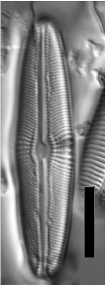Images
Click any image to enlarge...
LM image scalebar = 10 µm = 72 pixels
SEM image scalebar = 1 µm
Observations
| Observations: | Bart Van de Vijver |
|---|---|
| Length: | 25-40 µm |
| Width: | 6.0-9.5 µm |
| Striae: | Central: 15-18, Distal: 24-28 in 10 µm |
Description:
Valves lanceolate to linear-lanceolate with convex margins and broadly rounded apices. Valve face/mantle margin clearly rounded. Valve length 25-40 µm, valve width 6.0-9.5 µm. Axial area narrow and linear, only very weakly widened to form an elliptical central area with a rather large rectelevatum. Raphe straight and filiform with short, unilaterally hooked proximal raphe endings, never extending into the first row of areolae but terminating within the central area. Distal raphe divergent and offset from the apical axis. Distal endings deflected towards the same side as the proximal endings. Centrally, six or seven striae strongly radiate, more spaced than other striae and composed of slightly larger areolae. Number of central striae in 10 µm 15-18 increasing to 24-28 in 10 µm towards the valve ends. In LM, rather coarse striae presenting a crack near the axial area giving them a somewhat geniculate course. Striae composed of c-shaped to reniform areolae throughout the entire valve. Near the distal raphe ends, axial area widening with on each side two clearly enlarged canal puncta. Central area containing an elongate, rectangular central nodule. Internally, areolae occluded by a velum. Centrally, longitudinal canal broad but becoming quickly more rib-like distally, terminating at the helictoglossae. Near the apices, a distinct hyaline area present.
| Morphology: | Naviculoid |
|---|---|
| Distribution: |
Autecology:
Notes:
Based on its valve outline, Muelleria regigeorgiensis resembles Muelleria gibbula and M. linearis (O. Müller) Frenguelli, two species with a similar lanceolate to linear-lanceolate outline. Both species can be separated based on the structure and shape of the areolae. Both M. gibbula and M. linearis have rounded areolae whereas M. regigeorgiensis has c-shaped to reniform areolae. Moreover, both species lack the typical enlarged canal puncta that are typically present in M. regigeorgiensis. All other Muelleria species known so far can be distinguished using valve outline, valve dimensions or raphe structure as characterizing features.
Other sites with Muelleria regigeorgiensis
- Bellingshausen Station (moist habitats), King George Island
- James Ross Island (soil), James Ross Island
- Livingston Island (soil), Livingston Island
Original Type Description
| Author: | Van de Vijver & Spaulding 2009 |
|---|---|
| Length: | 25-40 µm |
| Width: | 6.0-9.5 µm |
| Striae: | Central: 15-18, Distal: 24-28 in 10 µm |
Original Description:
Valvae lineares marginibus leviter gibbosis apicibusque rotundatis. Longitudo 34-52 µm, latitudo 7-9 µm. Area axialis angusta linearisque. Area centralis late ovalis. Rectelevatum prominentiter adest. Raphe linearis uncis proximalibus late rotundatis separatisque. Extremitates proximales raphis usque ad margines valvae trans primam seriem areolarum extensae. Canalis longitudinalis habitu costae distinctae angustae. Striae transapicales leviter radiatae in media parte valvae ad paene parallellas ad polos. Striae centrales distantiores, manifeste radiatae. Striae, 12-15 in 10 µm ad centrum, 19-22 in 10µm ad polos. Duae puncta canalis adsunt.
New combination
| Author: |
|---|
Citations
Index Nominum Algarum (INA):
- Original
- New Combination
- If an INA link is available, it will be shown above
- The INA is a bibliographic reference "card file" for algal taxonomy, containing nearly 200,000 names of algae (in the broad sense).









